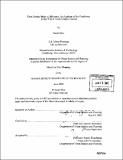| dc.contributor.advisor | John de Monchaux. | en_US |
| dc.contributor.author | Shin, Sarah (Sarah Seung Mok) | en_US |
| dc.contributor.other | Massachusetts Institute of Technology. Dept. of Urban Studies and Planning. | en_US |
| dc.date.accessioned | 2006-06-19T17:35:01Z | |
| dc.date.available | 2006-06-19T17:35:01Z | |
| dc.date.copyright | 2005 | en_US |
| dc.date.issued | 2005 | en_US |
| dc.identifier.uri | http://hdl.handle.net/1721.1/33039 | |
| dc.description | Thesis (M.C.P.)--Massachusetts Institute of Technology, Dept. of Urban Studies and Planning, 2005. | en_US |
| dc.description | Includes bibliographical references (p. 125-126). | en_US |
| dc.description.abstract | This paper looks at youth centers, specifically Boston-based Boys & Girls Clubs, as neighborhood-scale enclosed public spaces. Due to the lower income and high-risk populations the Boys & Girls Clubs of America serves, these clubhouses serve as field subjects for scrutinizing what conditions must be present for youth centers, an age- specific community space, to function and serve their intended populations. A series of interviews with Boys & Girls Clubs staff-persons and youth and observational studies were conducted to analyze how the clubhouses are used in the Boston area. Physical clubhouse designs, as well as programs, policies, users and personnel were compared. These analyses have led to a number of conclusions and recommendations concerning the establishment and function of youth centers. The variables found to be in common or have some relationship to each other include architectural process and design, staff, programs, accessibility, bureaucracy, facilities, seasonal adaptability, and neighborhood risk. Overall, design concerning clubhouse interiors was found to make a significant difference in how youth centers work while exterior architecture did not. | en_US |
| dc.description.statementofresponsibility | by Sarah Shin. | en_US |
| dc.format.extent | 126, [8] p. | en_US |
| dc.format.extent | 9068906 bytes | |
| dc.format.extent | 9075859 bytes | |
| dc.format.mimetype | application/pdf | |
| dc.format.mimetype | application/pdf | |
| dc.language.iso | eng | en_US |
| dc.publisher | Massachusetts Institute of Technology | en_US |
| dc.rights | M.I.T. theses are protected by copyright. They may be viewed from this source for any purpose, but reproduction or distribution in any format is prohibited without written permission. See provided URL for inquiries about permission. | en_US |
| dc.rights.uri | http://dspace.mit.edu/handle/1721.1/7582 | |
| dc.subject | Urban Studies and Planning. | en_US |
| dc.title | Does design make a difference : an analysis of the conditions under which youth centers operate | en_US |
| dc.type | Thesis | en_US |
| dc.description.degree | M.C.P. | en_US |
| dc.contributor.department | Massachusetts Institute of Technology. Department of Urban Studies and Planning | |
| dc.identifier.oclc | 62119655 | en_US |
